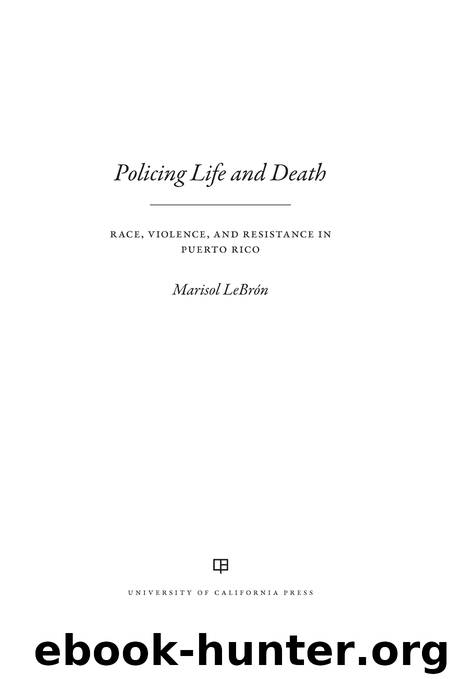Policing Life and Death by LeBron Marisol;

Author:LeBron, Marisol;
Language: eng
Format: epub
ISBN: 9780520971677
Publisher: University of California Press
THE THREAT OF CONFRONTATION
Months of organizing preceding and following the Paro Nacional eventually culminated in students at UPR-RP calling a forty-eight-hour strike on April 21, 2010. Students asked the administration to stop tuition hikes, reinstate fee waivers, and guarantee that none of the UPR campuses would be privatized. The students told administrators that if university officials failed to meet their demands, they would go on indefinite strike. The administration failed to take the students’ demands seriously, and as a result, students at the UPR-RP announced an indefinite strike on April 23 to force the administration into negotiations. The Association of Puerto Rican University Professors and the Brotherhood of Non-Teaching Employees of the University of Puerto Rico both urged their members to respect the picket line. By May 4, ten out of eleven campuses, which are spread out across the big island, had joined the indefinite strike. Only the Recinto de Ciencias Medicas, the University of Puerto Rico’s medical school, did not join the indefinite strike, which was due to the time-sensitive nature of its scientific investigations and its work with patients. The medical school did, however, hold a brief work stoppage in solidarity with the other campuses on strike.
The Fortuño administration stationed police on the perimeter of the UPR-RP campus immediately following the announcement of an indefinite strike. The police remained at the perimeter and did not enter the campus due to the política de no confrontación, or nonconfrontation policy, an informal agreement between university administrators and the PRPD that prohibited police from intervening in campus affairs. The nonconfrontation policy had emerged from a long history of state violence and repression directed at the student movement. As Abner Dennis Zayas told me, “There is a history of bloodshed here,” because the UPR, especially its Río Piedras campus, has long served as a site of pro-independence and leftist organizing.16
The UPR, since its founding in 1903, has played a central role in the US colonization of the archipelago. As a result, bitter debates and physical battles over the future of Puerto Rico and its people have often played out on the UPR’s campuses. The UPR was initially established with the goal of training public school teachers to aid in the Americanization of Puerto Rican children.17 During the university’s first two decades of existence, and as a result of its mission to advance American colonial rule and capitalist interests, students mostly came from the landowning and professional classes.18 By the 1930s, mirroring larger political and cultural shifts in Puerto Rico at the time, the UPR, while still bound up with American colonial rule, emerged as a “house of learning” dedicated to studying pressing issues within Puerto Rican society. From the 1930s to the 1980s, the university, and in particular the UPR-RP campus, not only played host to debates about Puerto Rico’s status in relationship to the United States, but also emerged as a site of violent confrontation between independentistas, annexationists, and police.
One of the first major instances of state repression and violence on
Download
This site does not store any files on its server. We only index and link to content provided by other sites. Please contact the content providers to delete copyright contents if any and email us, we'll remove relevant links or contents immediately.
Cecilia; Or, Memoirs of an Heiress — Volume 1 by Fanny Burney(32262)
Cecilia; Or, Memoirs of an Heiress — Volume 3 by Fanny Burney(31645)
Cecilia; Or, Memoirs of an Heiress — Volume 2 by Fanny Burney(31615)
The Great Music City by Andrea Baker(31032)
We're Going to Need More Wine by Gabrielle Union(18824)
All the Missing Girls by Megan Miranda(15186)
Pimp by Iceberg Slim(14079)
Bombshells: Glamour Girls of a Lifetime by Sullivan Steve(13853)
Talking to Strangers by Malcolm Gladwell(13075)
Fifty Shades Freed by E L James(13068)
Norse Mythology by Gaiman Neil(13047)
For the Love of Europe by Rick Steves(11996)
Crazy Rich Asians by Kevin Kwan(9059)
Mindhunter: Inside the FBI's Elite Serial Crime Unit by John E. Douglas & Mark Olshaker(8990)
The Lost Art of Listening by Michael P. Nichols(7315)
Enlightenment Now: The Case for Reason, Science, Humanism, and Progress by Steven Pinker(7038)
The Four Agreements by Don Miguel Ruiz(6488)
Bad Blood by John Carreyrou(6414)
Weapons of Math Destruction by Cathy O'Neil(6016)
